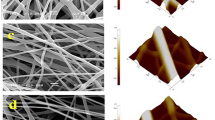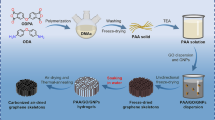Abstract
Poly(L-lactic acid) (PLLA)-based composites exhibit wide applications in many fields. However, most of hydrophilic fillers usually accelerate the hydrolytic degradation of PLLA, which is unfavorable for the prolonging of the service life of the articles. In this work, a small quantity of poly(methyl methacrylate) (PMMA) (2 wt%–10 wt%) was incorporated into the PLLA/carbon nanotubes (CNTs) composites. The effects of PMMA content on the dispersion of CNTs as well as the microstructure and hydrolytic degradation behaviors of the composites were systematically investigated. The results showed that PMMA promoted the dispersion of CNTs in the composites. Amorphous PLLA was obtained in all the composites. Largely enhanced hydrolytic degradation resistance was achieved by incorporating PMMA, especially at relatively high PMMA content. Incorporating 10 wt% PMMA led to a dramatic decrease in the hydrolytic degradation rate from 0.19 %/h of the PLLA/CNT composite sample to 0.059 %/h of the PLLA/PMMA-10/CNT composite sample. The microstructure evolution of the composites was also detected, and the results showed that no crystallization occurred in the PLLA matrix. Further results based on the interfacial tension calculation showed that the enhanced hydrolytic degradation resistance of the PLLA matrix was mainly attributed to the relatively strong interfacial affinity between PMMA and CNTs, which prevented the occurrence of hydrolytic degradation at the interface between PLLA and CNTs. This work provides an alternative method for tailoring the hydrolytic degradation ability of the PLLA-based composites.
Similar content being viewed by others
References
Jia, L.; Zhang, W. C.; Tong, B.; Yang, R. J. Crystallization, mechanical and flame-retardant properties of poly(lactic acid) composites with DOPO and DOPO-POSS. Chinese J. Polym. Sci.2018, 36, 871–879.
Karamanlioglu, M.; Preziosi, R.; Robson, G. D. Abiotic and biotic environmental degradation of the bioplastic polymer poly(lactic acid): A review. Polym. Degrad. Stab.2017, 137, 122–130.
Girdthep, S.; Sankong, W.; Pongmalee, A.; Saelee, T.; Punyodom, W.; Meepowpan, P.; Worajittiphon, P. Enhanced crystallization, thermal properties, and hydrolysis resistance of poly(L-lactic acid) and its stereocomplex by incorporation of graphene nanoplatelets. Polym. Test.2017, 61, 229–239.
Holcapkova, P.; Stloukal, P.; Kucharczyk, P.; Omastova, M.; Kovalcik, A. Anti-hydrolysis effect of aromatic carbodiimide in poly(lactic acid) wood flour composites. Composites Part A2017, 103, 283–291.
Stloukal, P.; Jandikova, G.; Koutny, M.; Sedlařík, V. Carbodiimide additive to control hydrolytic stability and biodegradability of PLA. Polym. Test.2016, 54, 19–28.
Jandíková, G.; Stoplova, P.; Di Martino, A.; Stloukal, P.; Kucharczyk, P.; Machovsky, M.; Sedlarik, V. Effect of a hybrid zinc stearatesilver system on the properties of polylactide and its abiotic and the biotic degradation and antimicrobial activity thereof. Chinese J. Polym. Sci.2018, 36, 925–933.
Tsuji, H.; Nakahara, K. Poly(L-lactide). IX. Hydrolysis in acid media. J. Appl. Polym. Sci.2002, 86, 186–194.
Tsuji, H.; Ikada, Y. Properties and morphology of poly(L-lactide). II. Hydrolysis in alkaline solution. J. Polym. Sci., Part A: Polym. Chem.1998, 36, 59–66.
Tsuji, H.; Ikarashi, K. In vitro hydrolysis of poly(L-lactide) crystalline residues as extended-chain crystallites. Polym. Degrad. Stab.2004, 85, 647–656.
Xu, L.; Crawford, K.; Gorman, C. B. Effects of temperature and pH on the degradation of poly(lactic acid) brushes. Macromolecules2011, 44, 4777–4782.
Chen, H. M.; Feng, C. X.; Zhang, W. B.; Yang, J. H.; Huang, T.; Zhang, N.; Wang, Y. Hydrolytic degradation behavior of poly(L-lactide)/carbon nanotubes nanocomposites. Polym. Degrad. Stab.2013, 98, 198–208.
Chen, H. M.; Wang, Y. P.; Chen, J.; Yang, J. H.; Zhang, N.; Huang, T.; Wang, Y. Hydrolytic degradation behavior of poly(L-lactide)/SiO2 composites. Polym. Degrad. Stab.2013, 98, 2672–2679.
Chen, H. M.; Shen, Y.; Yang, J. H.; Huang, T.; Zhang, N.; Wang, Y.; Zhou, Z. W. Molecular ordering and α′-form formation of poly(L-lactide) during the hydrolytic degradation. Polymer2013, 54, 6644–6653.
Iniguez-Franco, F.; Auras, R.; Burgess, G.; Holmes, D.; Fang, X.; Rubino, M.; Soto-Valdez, H. Concurrent solvent induced crystallization and hydrolytic degradation of PLA by waterethanol solutions. Polymer2016, 99, 315–323.
Wang, Y. P.; Xiao, Y. J.; Duan, J.; Yang, J. H.; Wang, Y.; Zhang, C. L. Accelerated hydrolytic degradation of poly(lactic acid) achieved by adding poly(butylene succinate). Polym. Bull.2015, 73, 1067–1083.
Oyama, H. T.; Tanishima, D.; Ogawa, R. Biologically safe poly(L-lactic acid) blends with tunable degradation rate: Microstructure, degradation mechanism, and mechanical properties. Biomacromolecules2017, 18, 1281–1292.
Huang, Y.; Chen, F.; Pan, Y.; Chen, C.; Jiang, L.; Dan, Y. Effect of hydrophobic fluoropolymer and crystallinity on the hydrolytic degradation of poly(lactic acid). Eur. Polym. J.2017, 97, 308–318.
Ma, P. M.; Xu, P. W.; Zhai, Y. H.; Dong, W. F.; Zhang, Y.; Chen, M. Q. Biobased poly(lactide)/ethylene-co-vinyl acetate thermoplastic vulcanizates: Morphology evolution, superior properties, and partial degradability. ACS Sustain. Chem. Eng.2015, 3, 2211–2219.
Andersson, S. R.; Hakkarainen, M.; Inkinen, S.; Sodergard, A.; Albertsson, A. C. Customizing the hydrolytic degradation rate of stereocomplex PLA through different PDLA architectures. Biomacromolecules2012, 13, 1212–1222.
Arias, V.; Hoglund, A.; Odelius, K.; Albertsson, A. C. Tuning the degradation profiles of poly(L-lactide)-based materials through miscibility. Biomacromolecules2014, 15, 391–402.
Jašo, V.; Glenn, G.; Klamczynski, A.; Petrović, Z. S. Biodegradability study of polylactic acid/thermoplastic polyurethane blends. Polym. Test.2015, 47, 1–3.
Wang, Y. P.; Wei, X.; Duan, J.; Yang, J. H.; Zhang, N.; Huang, T.; Wang, Y. Greatly enhanced hydrolytic degradation ability of poly(L-lactide) achieved by adding poly(ethylene glycol). Chinese J. Polym. Sci.2017, 35, 386–399.
Chen, H.; Chen, J.; Chen, J.; Yang, J.; Huang, T.; Zhang, N.; Wang, Y. Effect of organic montmorillonite on cold crystallization and hydrolytic degradation of poly(L-lactide). Polym. Degrad. Stab.2012, 97, 2273–2283.
Elsawy, M. A.; Kim, K. H.; Park, J. W.; Deep, A. Hydrolytic degradation of polylactic acid (PLA) and its composites. Renew. Sust. Energ. Rev.2017, 79, 1346–1352.
Reddy, N.; Nama, D.; Yang, Y. Poly(lactic acid)/polypropylene polyblend fibers for better resistance to degradation. Polym. Degrad. Stab.2018, 93, 233–241.
Yan, S.; Yin, J.; Yang, Y.; Dai, Z.; Ma, J.; Chen, X. Surface-grafted silica linked with L-lactic acid oligomer: A novel nanofiller to improve the performance of biodegradable poly(L-lactide). Polymer2007, 48, 1688–1694.
Luo, Y. B.; Wang, X. L.; Wang, Y. Z. Effect of TiO2 nanoparticles on the long-term hydrolytic degradation behavior of PLA. Polym. Degrad. Stab.2012, 97, 721–728.
Duan, J.; Xie, Y. N.; Yang, J. H.; Huang, T.; Zhang, N.; Wang, Y.; Zhang, J. H. Graphene oxide induced hydrolytic degradation behavior changes of poly(L-lactide) in different mediums. Polym. Test.2016, 56, 220–228.
Shirahase, T.; Komatsu, Y.; Tominaga, Y.; Asai, S.; Sumita, M. Miscibility and hydrolytic degradation in alkaline solution of poly(L-lactide) and poly(methyl methacrylate) blends. Polymer2006, 47, 4839–4844.
Hao, X.; Kaschta, J.; Pan, Y.; Liu, X.; Schubert, D. W. Intermolecular cooperativity and entanglement network in a miscible PLA/PMMA blend in the presence of nanosilica. Polymer2016, 82, 57–65.
Boudaoud, N.; Benali, S.; Mincheva, R.; Satha, H.; Raquez, J. M.; Dubois, P. Hydrolytic degradation of poly(L-lactic acid)/poly(methyl methacrylate) blends. Polym. Int.2018, 67, 1393–1400.
Fischer, E. W.; Sterzel, H. J.; Wegner, G. Investigation of the structure of solution grown crystals of lactide copolymers by means of chemical reactions. Colloid Polym. Sci.1973, 251, 980–990.
Liu, L.; Wang, Y.; Xiang, F. M.; Li, Y. L.; Han, L.; Zhou, Z. W. Effects of functionalized multiwalled carbon nanotubes on the morphologies and mechanical properties of PP/EVA blend. J. Polym. Sci., Part B: Polym. Phys.2009, 47, 1481–1491.
Li, Y. L.; Wang, Y.; Liu, L.; Han, L.; Xiang, F. M.; Zhou, Z. W. Crystallization improvement of poly(L-lactide) induced by functionalized multiwalled carbon nanotubes. J. Polym. Sci., Part B: Polym. Phys.2009, 47, 326–339.
Pantani, R.; Sorrentino, A. Influence of crystallinity on the biodegradation rate of injection-moulded poly(lactic acid) samples in controlled composting conditions. Polym. Degrad. Stab.2013, 98, 1089–1096.
Kulinski, Z.; Piorkowska, E. Crystallization, structure and properties of plasticized poly(L-lactide). Polymer2005, 46, 10290–10300.
Rodriguez, E.; Shahbikian, S.; Marcos, B.; Huneault, M. A. Hydrolytic stability of polylactide and poly(methyl methacrylate) blends. J. Appl. Polym. Sci.2018, 135, 45991.
Hao, X. Q.; Kaschta, J.; Liu, X. H.; Pan, Y.; Schubert, D. W. Entanglement network formed in miscible PLA/PMMA blends and its role in rheological and thermo-mechanical properties of the blends. Polymer2015, 80, 38–45.
Zhang, J. M.; Duan, Y. X.; Sato, H.; Tsuji, H.; Noda, I.; Yan, S.; Ozaki, Y. Crystal modifications and thermal behavior of poly(L-lactic acid) revealed by infrared spectroscopy. Macromolecules2005, 38, 8012–8021.
Pan, P. J.; Liang, Z. C.; Zhu, B.; Dong, T.; Inoue, Y. Roles of physical aging on crystallization kinetics and induction period of poly(L-lactide). Macromolecules2008, 41, 8011–8019.
Zhang, J. M.; Li, C. W.; Duan, Y. X.; Domb, A. J.; Ozaki, Y. Glass transition and disorder-to-order phase transition behavior of poly(L-lactic acid) revealed by infrared spectroscopy. Vib. Spectr.2010, 53, 307–310.
Berquier, J. M.; Arribart, H. Attenuated total reflection Fourier transform infrared spectroscopy study of poly(methyl methacrylate) adsorption on a silica thin film: Polymer/surface interactions. Langmuir1998, 14, 3716–3719.
Steiner, G.; Zimmerer, C.; Salzer, R. Characterization of metalsupported poly(methyl methacrylate) microstructures by FTIR imaging spectroscopy. Langmuir2006, 22, 4125–4130.
Li, M. X.; Kim, S. H.; Choi, S. W.; Goda, K.; Lee, W. I. Effect of reinforcing particles on hydrolytic degradation behavior of poly(lactic acid) composites. Composites Part B2016, 96, 248–254.
Raquez, J. M.; Habibi, Y.; Murariu, M.; Dubois, P. Polylactide (PLA)-based nanocomposites. Prog. Polym. Sci.2013, 38, 1504–1542.
Zhang, Z. X.; Wang, W. Y.; Yang, J. H.; Zhang, N.; Huang, T.; Wang, Y. Excellent electroactive shape memory performance of EVA/PCL/CNT blend composites with selectively localized CNTs. J. Phys. Chem. C2016, 120, 22793–22802.
Xie, Y. N.; Liu, D. F.; Sun, D. X.; Yang, J. H.; Qi, X. D.; Wang, Y. Crystallization and concentration fluctuation of miscible poly(vinylidene fluoride)/poly(methyl methacrylate) blends containing carbon nanotubes: Molecular weight dependence of poly(methyl methacrylate). Eur. Polym. J.2018, 105, 478–490.
Xavier, P.; Bose, S. Multiwalled-carbon-nanotube-induced miscibility in near-critical PS/PVME blends: Assessment through concentration fluctuations and segmental relaxation. J. Phys. Chem. B2013, 117, 8633–8646.
Fowkes. F. M. Determination of interfacial tensions, contact angles, and dispersion forces in surfaces by assuming additivity of intermolecular interactions in surfaces. J. Phys. Chem. B1962, 66, 382–382.
Owens, D. K.; Wendt, R. C. Estimation of the surface free energy of polymers. J. Appl. Polym. Sci.1969, 13, 1741–1747.
Shi, Y. Y.; Yang, J. H.; Huang, T.; Zhang, N.; Chen, C.; Wang, Y. Selective localization of carbon nanotubes at the interface of poly(L-lactide)/ethylene-co-vinyl Acetate resulting in lowered electrical resistivity. Composites Part B2013, 55, 463–469.
Nuriel, S.; Liu, L.; Barber, A. H.; Wagner, H. D. Direct measurement of multiwall nanotube surface tension. Chem. Phys. Lett.2005, 404, 263–266.
Kyutoku, H.; Maeda, N.; Sakamoto, H.; Nishimura, H.; Yamada, K. Effect of surface treatment of cellulose fiber (CF) on durability of PLA/CF bio-composites. Carbohydr. Polym.2019, 203, 95–102.
Acknowledgments
This work was financially supported by the National Natural Science Foundation of China (No. 51473137), the International Science and Technology Cooperation Project of Sichuan Province (No. 2017HH0066), the International Science and Technology Cooperation Project of Chengdu (No. 2016-GH02-00097-HZ), and the Fundamental Research Funds for the Central Universities (2682019JQ04).
Author information
Authors and Affiliations
Corresponding authors
Rights and permissions
About this article
Cite this article
Yu, X., Jin, XZ., Huang, T. et al. Poly(methyl methacrylate)-induced Microstructure and Hydrolysis Behavior Changes of Poly(L-lactic acid)/Carbon Nanotubes Composites. Chin J Polym Sci 38, 195–204 (2020). https://doi.org/10.1007/s10118-019-2323-z
Received:
Accepted:
Published:
Issue Date:
DOI: https://doi.org/10.1007/s10118-019-2323-z




